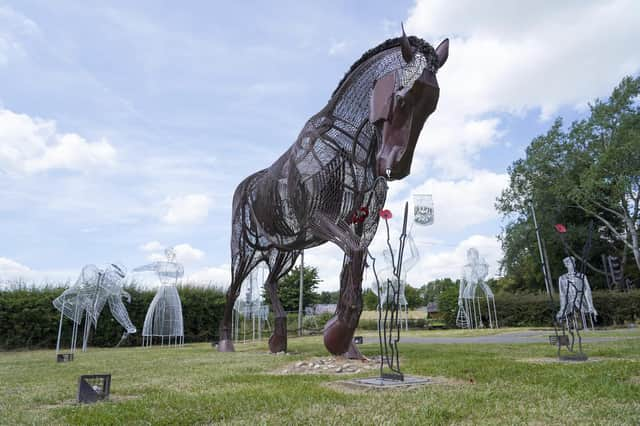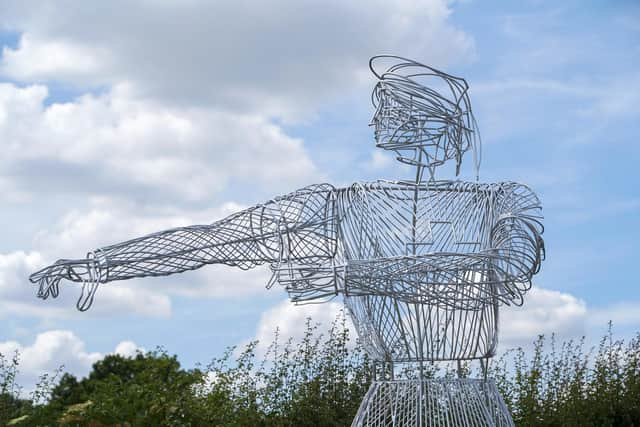Featherstone memorial to all those who fought at home during the war


Six sculptures recognising those who served in non-combat roles during World War One have been installed in Mill Pond Meadows nature reserve, Featherstone.
They were created by Midlands-based artist, Luke Perry and are made of galvanised steel wire, similar to the War Horse that was created in 2014 to mark the 100th year anniversary of the start of World War One.
Advertisement
Hide AdAdvertisement
Hide AdAs well as the War Horse sculpture, a woodland was planted with 353 trees - one for each of the servicemen who lost their lives in battle.


Mayor of Featherstone, Coun Jack Hutsby said: “Luke was tasked with creating a new permanent feature that encourages visitors to remember and learn about the past of Featherstone during World War One.
“I feel that the new sculptures bring an increased sense of pride in the town.”
The six new figures represent a coal worker, a munitions girl, a Voluntary Aid Detachment nurse, a Belgian refugee, a sense of loss and a child, and are raised up on stilt legs.
Advertisement
Hide AdAdvertisement
Hide AdThe tallest reaches 6.2 metres high, with the shortest standing at 2.5 metres and they have been positioned on the corner of the reserve where Wakefield Road meets Huntwick Lane.
The unveiling took place on Friday June 17. Featherstone Male Voice Choir opened proceedings followed by performances from the school choirs of Featherstone All Saints CofE Academy, Purston Infants School, Streethouse Primary School and St Thomas CE (VC) Junior School.
Luke then discussed his approach and inspiration for the project.
There was a two-minutes silence held at 11am followed by the official ribbon cutting by Coun Hutsby.
Advertisement
Hide AdAdvertisement
Hide AdLuke said: “One of the things I loved about the project was is how incredibly generous Featherstone is.
“There is an amazing amount of social care and awareness and they were really receptive to this idea I had to try and make a piece about non-combatants.
“People often forget the war was fought at home as well.”
Featherstone parish councillor Graham Isherwood said the sculptures mean a great deal to Featherstone.
He added: “The War Horse is a national and international success and we are immensely proud.
“We never saw the War Horse as the final thing on there.
Advertisement
Hide AdAdvertisement
Hide Ad“We had a meeting and discussed that, while it was hellish in the trenches there was a certain section of society that was left behind that had to continue the work that the men used to do.
“They were heroes in their own right.
“One of the statues represents children - they had to do what their dads had done and they had their childhood stolen from them.
“Another is for the Belgian refugees. Featherstone made the Belgian refugees feel very welcome.
Coun Isherwood said he felt one of the most important statues is for the muntions workers as many people from the town undertook this dangerous work during World War One.
Advertisement
Hide AdAdvertisement
Hide AdCoun Hutsby added: “I was honoured to be able to officially open the sculptures and I would like to thank all those who helped or assisted during the course of the project.
“I hope that many residents will come down and visit Luke’s amazing work.”
The individual statutes and what they represent.
Coal workers - Though the coal miners continued to suffer from poor working conditions, injury and mortality due to their work, low pay and other perils there was an incredible sense of social conscience. The resounding message throughout the war years was that of unflinching support for those who were in need.
Local Issues - Belgian Refugee: There were many issues suffered and tackled during the war years. The most indicative of Featherstone’s strong social conscience was the Belgian refugees.
Advertisement
Hide AdAdvertisement
Hide AdMunitions Girls - Munitionette: There were many local women who became munitions girls. These women worked in toxic and often highly dangerous roles to produce the explosives needed on the front.
Loss - Loss is a broad word and certainly covers a multitude of horrors during the period of the Great War. Many lost loved ones, almost all of the men serving were wounded or lost a comrade. Many lost their youth, limbs, health or mental health to the war.
Women’s Changing ROLES - VAD Nurse. After 1900 a huge push for women’s suffrage led to a massive upsurge in enthusiasm for women to have a greater responsibility in the running of the world and equal rights. The war called on this heavily.
Children’s contributions: Children bore the brunt of much of the hardships domestically with malnutrition and other ill effects of war. Despite this there was a huge push from local schools, clubs and organisations for support for soldiers, refugees both on the continent and in Britain and those who were affected by war.